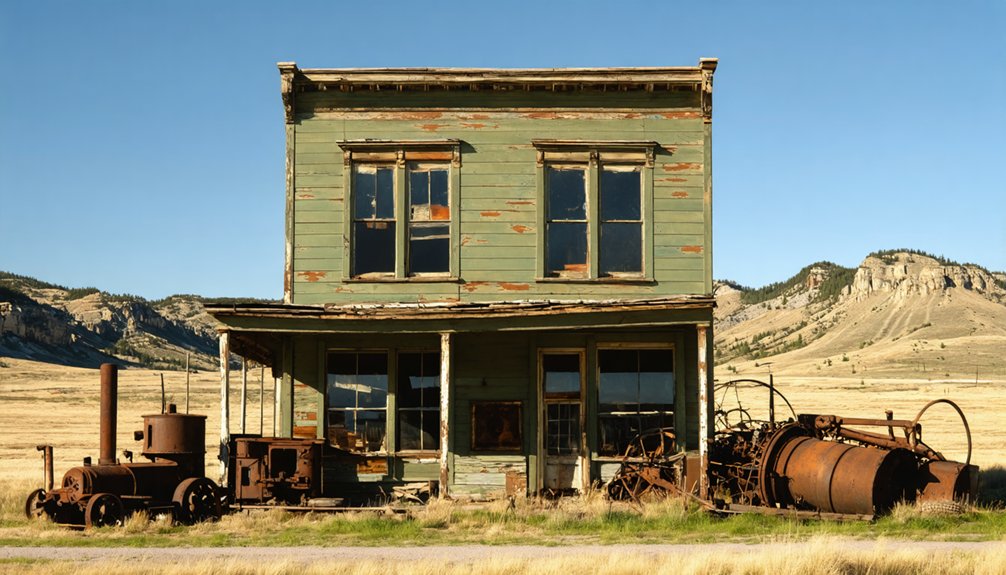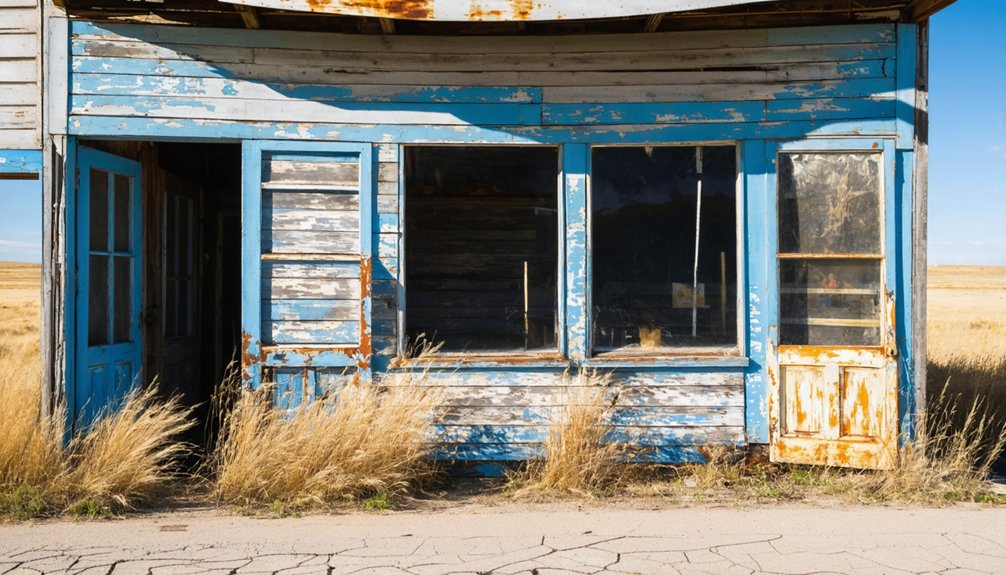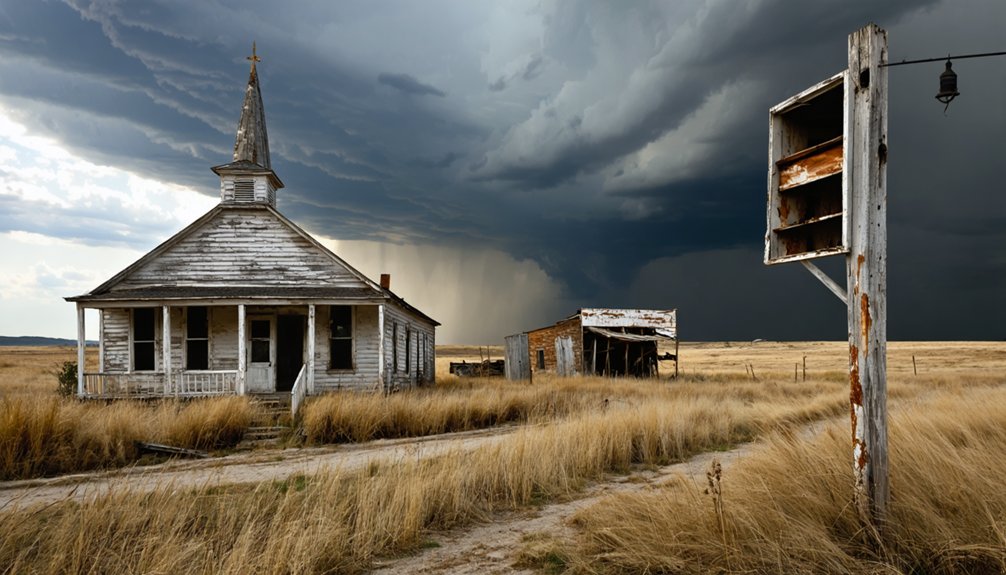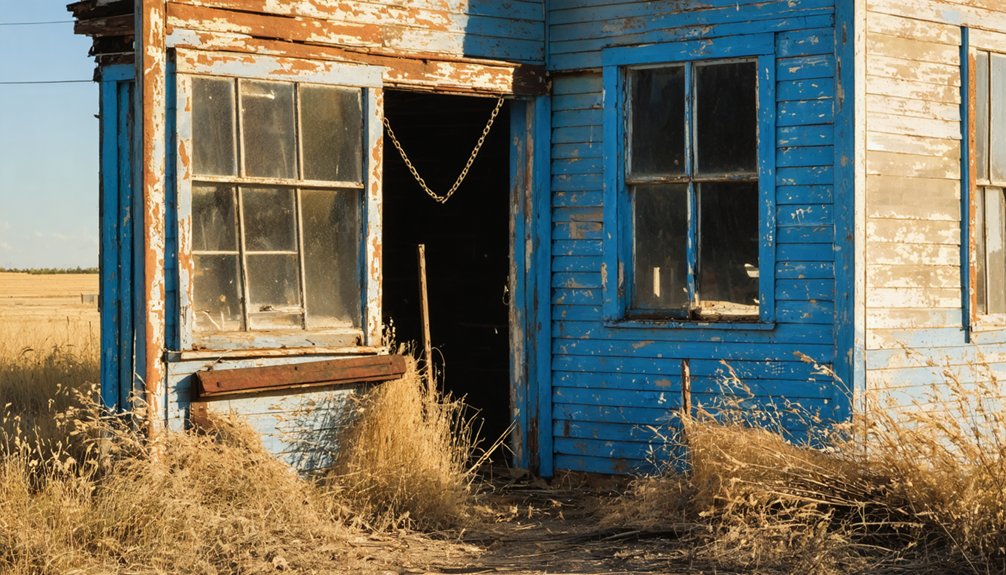You’ll find Mystic nestled in South Dakota’s Black Hills, where it began as a placer mining camp in 1876 during the region’s gold rush. Originally named Sitting Bull, the settlement was renamed Mystic in 1885 when its post office opened. The arrival of two major railroads in 1889 and 1906 transformed this modest mining camp into a bustling community. Today, 14 historic structures remain, telling tales of the Black Hills’ golden era.
Key Takeaways
- Founded in 1876 during the Black Hills gold rush, Mystic began as a mining camp and was officially recognized on the National Register in 1986.
- The town grew around railroad connections and mining operations, featuring a reduction mill and sawmill during its prime years.
- Historic structures include 14 buildings listed on the National Register, including the McCahan Memorial Chapel built in 1930.
- Mining operations declined due to resource exhaustion and technical failures, leading to the town’s eventual abandonment.
- Located in the Black Hills region, Mystic was connected to nearby mining communities through the Rochford Mining District network.
From Mining Camp to Ghost Town: Origins of Mystic
While the Black Hills gold rush drew thousands of prospectors to Deadwood and Lead, a smaller but significant strike along Castle Creek gave birth to the settlement of Sitting Bull in 1876.
You’ll find its origins traced to George Armstrong Custer‘s Black Hills Expedition of 1874, which led geologists Walter Jenney and Henry Newton to confirm gold deposits the following year.
The community dynamics were shaped by about 100 hardy souls who settled there by 1879, establishing basic mining techniques like placer mining, panning, and sluicing in the creek’s gravels.
The town was later recognized for its historical significance when it was named to the National Register in 1986.
While richer strikes in other areas prevented the camp from growing larger, the settlement persevered, eventually adopting the name Mystic in 1885 when its post office opened.
The arrival of the Chicago, Burlington & Quincy Railroad in 1889 brought new life to the mining camp, spurring increased mining activity and economic growth.
The Gold Rush Years: Early Settlement and Growth
You’ll find the roots of Mystic in the Black Hills gold rush of 1876, when prospectors established a placer mining camp they called Sitting Bull.
The rush came after prospectors discovered significant gold deposits in nearby Deadwood Gulch, with towns quickly reaching populations of 2,000 settlers.
Like many who pursued mystic craft, the settlers were drawn to the mysterious allure of hidden riches in the earth.
As multiple railroads converged on this promising location, you could see the camp transform into a bustling mining settlement.
The strategic position at the junction of rail lines helped Mystic grow from its humble mining camp origins into a proper frontier town.
Mining Camp Beginnings 1876
Three key events set Mystic’s founding in motion during 1876. First, geologists’ recent gold discoveries on Castle Creek sparked an influx of determined prospectors.
Second, these early miners established a small camp they’d name “Sitting Bull,” laying the groundwork for what you’d later know as Mystic.
Third, the nearby Rochford Mining District‘s formation created a network of interconnected mining communities. The district was established after three hunters discovered gold in August 1876.
You’ll find the mining techniques were primarily focused on placer mining, with prospectors working Castle Creek’s waters for loose gold deposits. Like other Black Hills locations, miners used free milling techniques to extract gold from the ore.
The social dynamics of the camp remained modest – unlike Deadwood’s booming settlement, Mystic’s population held steady at around 100 residents.
While miners tested various extraction methods, many eventually moved on to richer claims, though the faithful few maintained operations through steady placer mining.
Railroad Growth Spurs Development
The arrival of the Chicago, Burlington & Quincy Railroad in 1889 transformed Mystic from an isolated mining outpost into a bustling frontier hub.
You’d have witnessed unprecedented railroad expansion as the Dakota, Wyoming & Missouri Railroad (Crouch Line) added a second rail connection in 1906, conquering the challenging terrain with 100 bridges and 14 complete circles along Rapid Creek.
This dual rail access sparked remarkable community growth.
You’d have seen James Hartgering’s million-dollar Mystic Reduction Mill rise alongside the tracks, processing 150 tons of ore daily.
The railroads didn’t just serve the mines – they enabled George Frink’s sawmill operations from 1919 to 1952, diversifying the local economy.
Even after the devastating 1907 flood, Mystic’s strategic position as a two-railroad town guaranteed its rapid recovery.
Railroad Development Transforms the Valley
You’ll find Mystic’s transformation began in 1889 when the Chicago, Burlington and Quincy Railroad built the first major rail line connecting the settlement to Deadwood.
By 1906, the Crouch Line had established additional rail service, creating an essential transportation hub that linked Mystic’s mining operations to broader markets.
These rail connections spurred significant economic growth, enabling the efficient transport of coal, timber, and gold ore while supporting the town’s new reduction mill, which processed 150 tons of ore daily.
The development of Mystic’s railways aligned with the region’s Golden Age of railroading, which brought unprecedented prosperity to the northern Black Hills starting in 1890.
Rail Lines Meet Here
Once a modest gold placer mining camp called Sitting Bull, Mystic transformed into an essential transportation hub when the Chicago, Burlington and Quincy Railroad arrived in 1889.
The railroad expansion sparked rapid growth, bringing new opportunities and connecting the town to Deadwood’s bustling mining district.
You’ll discover three key developments that shaped Mystic’s rail heritage:
- The arrival of the Rapid City, Black Hills, and Western Railroad in 1906
- Construction of the ambitious 34-mile Crouch Line with its steep grades and bridges
- Development of community infrastructure to support the growing workforce
When both rail lines converged in Mystic, you could transport everything from Wyoming coal to Black Hills timber and gold ore.
Even after the devastating flood of 1907, the town’s resilient spirit kept the rails running and commerce flowing.
Economic Growth Through Transport
During Mystic’s most prosperous era, railroad development transformed this Black Hills valley into a bustling industrial center.
You would’ve seen the economic strategies unfold as the 1906 Crouch Line connected Mystic to Rapid City, enabling the transport of Wyoming coal, timber, and precious gold ore across a complex 34-mile route.
The transportation benefits proved remarkable – by 1901, you could find a $1 million reduction mill processing 150 tons of ore daily using cutting-edge electro-cyanide technology.
When the 1907 flood washed out bridges, quick reconstruction kept commerce flowing. The rail networks linked Mystic to major lines like the Chicago, Burlington and Quincy, while supporting the town’s first electric placer-mining dredge in 1909 and a productive sawmill that operated from 1918 to 1952.
Mining Operations and Industrial Heritage
The mining legacy of Mystic began with simple placer operations along Castle Creek in the mid-1870s, when prospectors at the Sitting Bull camp first searched for gold.
Along Castle Creek, Mystic’s humble mining roots trace back to placer gold seekers at Sitting Bull camp in the 1870s.
During this period, General Custer named Castle Creek after discovering the area’s potential in 1875.
As mining technology evolved, you’ll find that Mystic became a testing ground for innovative but challenging industrial processes:
- A basic 10-stamp mill processed gold ore from 1895 to 1902
- The $1 million Mystic Reduction Mill attempted electro-cyanide processing in 1900
- The first electric placer-mining dredge in the Black Hills arrived in 1909
These ambitious ventures faced significant industrial challenges.
The electro-cyanide process failed when crushed ore solidified in tanks, while the electric dredge lasted less than a year before being abandoned due to poor returns.
Life in a Black Hills Mining Community

Life in Mystic flourished beyond its mining roots as the town grew from a simple placer camp into a diverse Black Hills community. You’d have found a tight-knit population showing remarkable community resilience, with families and workers gathering at the Presbyterian church and local schoolhouse to maintain their cultural heritage.
While miners formed the backbone of early Mystic, you’d have seen railroad workers, sawmill laborers, and entrepreneurs adding to the town’s character. The discovery of gold in French Creek had originally drawn prospectors to the Black Hills region. Like many of the ghost towns in the region, Mystic’s ultimate decline was linked to the exhaustion of its natural resources.
By the early 1900s, you could’ve shopped at the grocery store, visited the blacksmith, or watched trains pass through the bustling depot.
During the Depression, the CCC camp brought new energy, with workers planting over 1.5 million trees by 1937.
Even President Coolidge’s 1927 visit highlighted Mystic’s evolution from a mining camp to a significant Black Hills destination.
The Rise and Fall of the Mystic Reduction Mill
Standing proudly beside the railroad tracks in 1900, Mystic’s ambitious four-story reduction mill represented a million-dollar gamble on cutting-edge gold extraction technology.
You would’ve witnessed James Hartgering and his Chicago investors betting big on an experimental electrochemical process that promised to revolutionize ore processing in the Black Hills.
The mill’s innovative but ultimately troubled operations faced:
- Technical failures when ore settled and solidified in treatment tanks
- Mounting costs from repeated machinery upgrades and renovations
- Fierce competition from simpler, proven extraction methods
Historic Buildings and Preserved Architecture

While the ambitious reduction mill eventually crumbled, other structures in Mystic have endured the test of time, earning recognition on the National Register of Historic Places in 1986.
You’ll find 14 historic buildings scattered throughout the townsite district, showcasing a blend of mining town and rural architectural styles. The McCahan Memorial Chapel, built in 1930, stands as a monument to preservation efforts, its log structure maintaining its original character.
A restored schoolhouse offers another glimpse into Mystic’s architectural heritage, while tourist cabins, a granary, and various outbuildings complete the historical landscape.
These preserved structures tell the story of life in this Black Hills mining community, each building offering its own chapter in Mystic’s compelling narrative.
Transportation Networks and Economic Impact
As railroads transformed the American West, Mystic’s destiny became inextricably linked to the arrival of two major lines: the Rapid City, Black Hills & Western and the Dakota, Wyoming & Missouri River (“Crouch Line”).
This transportation infrastructure revolutionized the town’s economic sustainability, enabling it to pivot from mining to timber production when ore deposits depleted.
The railroad’s impact was profound in three key ways:
- The Crouch Line’s engineering marvel featured 14 complete circles and 100 bridges across 34 miles.
- Rail depots served as crucial hubs for mail, telegraph, and freight services until 1983.
- George Frink’s sawmill operations thrived from 1919-1952 thanks to reliable rail transport.
Today, you’ll find the Mickelson Trail following these historic rail corridors, preserving Mystic’s transportation legacy.
The Path to Abandonment

The vibrant railroad networks that once sustained Mystic couldn’t prevent its inevitable decline in the early 1900s.
As gold yields diminished and mining operations faltered, economic incentives for staying in the area vanished. The experimental Mystic Reduction Mill’s failure in 1913 dealt another blow to the town’s mining prospects.
You’d have witnessed a steady population decline as miners and their families sought opportunities elsewhere, particularly in bustling towns like Lead and Deadwood.
The town’s over-reliance on mining proved fatal – when the mines couldn’t sustain workers, local businesses folded and essential services disappeared.
Without alternative industries to replace mining jobs, Mystic’s isolation grew as transportation routes evolved away from the town.
Exploring Mystic’s Remnants Today
You’ll find 14 preserved buildings at Mystic’s National Register Historic District, including a granary, boardinghouse, chapel, and tourist cabins that offer glimpses into mining camp life.
To reach these historic structures, take Forest Service Road 231 north from Hill City for 12 miles until you spot the ruins along Castle Creek.
While exploring the site via the Mickelson Trail or surrounding forest roads, remember to respect the remaining structures by viewing them from a safe distance, as climbing on the aging buildings isn’t permitted.
Historic Structures Still Standing
While most Black Hills ghost towns have crumbled into obscurity, Mystic’s remaining structures offer a rare glimpse into South Dakota’s mining and railroad heritage.
The town’s architectural significance earned it a spot on the National Register of Historic Places in 1986, with fourteen contributing buildings demonstrating historic preservation worthy of recognition.
Today, you’ll find:
- The McCahan Memorial Chapel, built in 1930, standing as the best-preserved structure and the town’s last intact public building
- Original summer cottages scattered throughout the site, though most are deteriorating
- Vernacular buildings constructed from local materials, showcasing typical Black Hills mining camp architecture
While most structures are in advanced decay, these remaining buildings tell the story of a once-thriving community that helped shape the region’s mining and railroad legacy.
Trail Access and Directions
Finding Mystic’s historic remnants starts at the well-marked Mystic Trailhead, located 12 miles north of Hill City along the George S. Mickelson Trail.
You’ll find the trailhead at coordinates 44°04′37″N, 103°38′30″W, accessible via Mystic Road or by taking Rochford Road west from Highway 385.
Trail accessibility is excellent, with maintained gravel surfaces and moderate 4% grades that won’t overtax your legs.
While you’ll need a suitable vehicle for the gravel access roads, especially in poor weather, navigational tools like Avenza Maps and clear trail markers make exploration straightforward.
The trailhead serves as point No. 7 on the 109-mile trail segment, offering access to Castle Creek views, historic mine sites, and the McCahan Memorial Chapel’s remains.
Frequently Asked Questions
Are There Any Reported Paranormal Activities or Ghost Sightings in Mystic?
Among 600+ Black Hills ghost towns, you won’t find verified ghost encounters in Mystic. Despite its evocative name, no paranormal investigations have produced evidence of supernatural activity in this historic mining settlement.
What Happened to the Families Who Lived in Mystic After Abandonment?
You’ll find Mystic history shows families scattered to nearby towns like Deadwood and Rapid City. Family relocation happened gradually as they sought jobs, with many integrating into other Black Hills communities.
Can Visitors Camp or Metal Detect in the Mystic Area?
Like a freedom-seeking hawk, you’ll find dispersed camping’s allowed near Mystic, but you’ll need to follow regulations: stay 100 feet from water, no fires. Metal detecting rules require checking local permits first.
Does Anyone Still Own Private Property Within the Ghost Town?
You’ll find it difficult to verify current private property ownership within the town, as ghost towns like this typically consolidate into single ownership or revert to county control through town history.
What Wildlife Commonly Inhabits the Abandoned Buildings and Surrounding Area?
Like nature’s squatters, you’ll find deer, coyotes, and foxes claiming the ruins. Inside abandoned buildings, you’ll spot bats, raccoons, and various birds making homes amid the crumbling walls.
References
- https://www.powderhouselodge.com/black-hills-attractions/fun-attractions/ghost-towns-of-western-south-dakota/
- https://www.legendsofamerica.com/mystic-south-dakota/
- https://www.sdhspress.com/journal/south-dakota-history-2-2/some-black-hills-ghost-towns-and-their-origins/vol-02-no-2-some-black-hills-ghost-towns-and-their-origins.pdf
- https://www.historynet.com/ghost-towns-mystic-south-dakota/
- https://www.sdpb.org/rural-life-and-history/2023-08-21/some-black-hills-ghost-towns-and-their-origins
- https://www.blackhillsbadlands.com/blog/post/old-west-legends-mines-ghost-towns-route-reimagined/
- https://ruralresurrection.com/ghost-towns-mystic-south-dakota/
- https://westernmininghistory.com/towns/south-dakota/mystic/
- https://unusualplaces.org/explore-a-scenic-ghost-town-in-mystic-south-dakota/
- https://www.legendsofamerica.com/south-dakota-ghost-towns/



